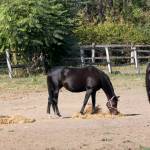Alfalfa Hay for Horses May Contain Toxic Blister Beetles

After a long and unusually cold winter, some horse owners are running low on hay and may pick up whatever type of hay is available in order to keep forage in front of their horses until the pastures begin to grow. All hay should be checked for mold before it is fed, and it’s best to introduce the new hay gradually, mixing a little more of the new batch into decreasing amounts of the older hay over the course of several days. This is especially important if horses have been eating grass hay and are going to be switched to something quite different, such as alfalfa.
Alfalfa (lucerne) hay is classified as a high-quality forage for horses, providing significant levels of both energy and calcium. Most horses like the taste and will enthusiastically eat alfalfa when they may only pick through hay of lesser quality. However, owners offering alfalfa to their horses need to be aware of a potential danger: blister beetles. These insects may be picked up as mowed alfalfa is baled. Blister beetles typically inhabit semi-arid regions of the western United States. The hay-producing states known to have the biggest problems with blister beetles are Texas and Oklahoma. To date, blister beetle poisoning has not reportedly been a problem for hay grown in the Treasure Valley region of Idaho.
Blister beetles contain a toxic substance, cantharidin, that causes irritation and ulceration in the horse’s intestine. Discomfort from this inflammation is shown as colic signs in affected horses.
Horses showing signs of colic should be examined by a veterinarian because while some colic cases resolve without treatment, others can rapidly progress and become life-threatening. If colicky horses have had recent dietary changes, such as beginning to eat alfalfa or another unfamiliar type of hay, the examining veterinarian should be advised of this.
Treatment for some types of colic may include administering mineral oil to act as a laxative, helping to move material through the horse’s digestive tract. This treatment might be a bad idea if the horse is suffering from ingestion of blister beetles, according to research conducted by scientists at Oklahoma State University. In the study, rats were given cantharidin and one group was treated with mineral oil. Rats in other groups were treated with either activated charcoal or smectite, and one group of untreated rats served as a control. Rats in the mineral oil group had the highest mortality rate and also showed more cantharidin in their urine, indicating that mineral oil might have actually increased rather than decreased the rate of absorption. Rats in the other treatment groups and the control groups had lower mortality rates. While the results of studies with rats can’t always be applied to horses, the researchers suggested that horses suspected of having blister beetle toxicity should be treated with activated charcoal or smectite rather than mineral oil.
Activated charcoal works by allowing a toxic substance to adsorb, or attach to the surface of the charcoal, passing along the digestive tract rather than being absorbed. Smectite refers to a class of hydrous aluminium phyllosilicates (clay minerals) that form in the presence of water, have high cation exchange capacities, and can be used to remove toxins or impurities from liquids. Interestingly, smectite clay minerals have been detected by the Mars rover, upholding the theory that this planet has had water at some time.








